In a recent study published in Nature, researchers investigated the cellular tropism, replication competence, persistence and evolution of severe acute respiratory syndrome coronavirus 2 (SARS-CoV-2) in humans, and associated histopathological changes in infected tissues.
 Study: SARS-CoV-2 infection and persistence in the human body and brain at autopsy. Image Credit: Surasak_Photo/Shutterstock
Study: SARS-CoV-2 infection and persistence in the human body and brain at autopsy. Image Credit: Surasak_Photo/Shutterstock
Coronavirus disease 2019 (COVID-19) has reportedly caused multiple organ derangements in the acute period, with a few infected individuals developing persistent symptoms, referred to as PASC (post-acute sequelae of COVID-19). However, the non-respiratory disease burden and the duration of SARS-CoV-2 clearance from non-respiratory tissues such as the brain has not been extensively investigated.
About the study
In the present study, researchers mapped and quantified the distribution, proliferation, and cellular tropism of SARS-CoV-2 in non-respiratory human body tissues such as the brain from the acute COVID-19 period to >7.0 months after the onset of symptoms.
Autopsied brain specimens of 44 unvaccinated and deceased COVID-19 patients were analyzed, and extensive CNS (central nervous system) sampling was performed for 11 individuals between April 26, 2020, and March 2, 2021. Polymerase chain reaction (PCR) analysis was performed to confirm SARS-CoV-2 positivity, and 38 samples were found to be SARS-CoV-2-positive. Three samples (P27, P36, and P37) were seronegative for SARS-CoV-2, and sera were not available for three cases (P3, P4, and P15).
Droplet digital PCR (ddPCR) analysis was performed for SARS-CoV-2 N (nucleocapsid) gene quantification, and ISH (in-situ hybridization) analysis was performed to validate the ddPCR results and to determine SARS-CoV-2 cell tropism. The IF (immunofluorescence) and IHC (immunohistochemistry) analyses were performed further to verify the viral presence within human brain tissues.
Further, subgenomic ribonucleic acid (RNA) was detected using real-time quantitative reverse transcription-PCR (RT– qPCR) analysis, and virus isolation experiments were performed using Vero E6 cells to demonstrate proliferation-capable SARS-CoV-2 among tissues of respiratory and another origin. SARS-CoV-2 S (spike) gene variant diversity and distribution were measured using HT-SGS (high-throughput, single-genome amplification and sequencing) analysis for six individuals.
Among the autopsied specimens, 17, 13, and 14 were categorized as early cases, mid-cases, and late cases based on the day of infection (d) at death within 14 days, between 15 days and 30 days, and beyond 31 days, respectively. Further, image analysis on interventricular septal tissues of 16 individuals was performed to assess the association between SARS-CoV-2 N RNA detected by ddPCR analysis and SARS-CoV-2 S RNA detected by ISH analysis. Furthermore, N protein-targeted ISH assays, IF analysis, and IHC-based analyses were performed to validate SARS-CoV-2 detection and distribution in the CNS.
Results
Among the study individuals, 30% were women, with a median age value of 63 years, and 61% of them suffered from at least three comorbid conditions. The median duration between the onset of symptoms to hospital admission and death was six days and 19 days, respectively, and the median post-mortem duration was 22 hours.
SARS-CoV-2 ribonucleic acid was present at 84 anatomical sites in significantly greater amounts among respiratory tissues than other tissues. SARS-CoV-2 RNA levels among early cases, mid-cases, and late-cases were 2.0 log10 nucleocapsid gene copies for every nanogram RNA, 1.4 log10 nucleocapsid gene copies for every nanogram RNA and 0.7 log10 nucleocapsid gene copies for every nanogram RNA, respectively. SARS-CoV-2 ribonucleic acid was detected in the perimortem sera of 11 and one early cases and mid-cases, respectively.
SARS-CoV-2 ribonucleic acid was persistently present in several tissues of late cases, despite being below detectable levels in sera of any case. SARS-CoV-2 ribonucleic acid was identified within the CNS among 91% (n= 10) cases, including across most brain areas evaluated in five (out of six) late cases. SARS-CoV-2 subgenomic ribonucleic acid was detected across all tissues and in several body fluids, including serum, vitreous humor, and pleural fluid.
The subgenomic ribonucleic acid RT-qPCR analysis and ddPCR analysis findings correlated closely for 1,025 specimens, particularly among 369 respiratory samples, 496 early cases, and 302 specimens showing SARS-CoV-2 positivity by RT-qPCR and ddPCR analyses. SARS-CoV-2 was isolated among Vero E6 cells from 45% (n=25) of specimens from the lymph nodes, heart, adrenal gland, gastrointestinal tissues, and ophthalmic tissues of early cases.
In addition, SARS-CoV-2 was isolated from the P38 thalamus among Vero E6-transmembrane serine protease 2 (TMPRSS2)-T2A-angiotensin-converting enzyme 2 (ACE2) cells. HT-SGS analysis of 46 specimens from six individuals did not show any non-synonymous SARS-CoV-2 genomic diversity in respiratory tissues and other tissues for P18, P19, and P27. Among P27 samples, two SARS-CoV-2 haplotypes, each comprising a synonymous mutation, were detected preferentially among non-respiratory tissues such as the mediastinal lymph nodes and the left and right ventricles.
In P38, residue D80F was detected in all 31 respiratory, but none of the 490 cranial sequences and residue G1219V was limited to the cranial variants. Among intraventricular septum tissues, the mean SARS-CoV-2 N gene copies/nanogram RNA correlated significantly with the median SARS-CoV-2 S RNA-positive cells. In the second ISH assay, SARS-CoV-2 RNA and protein were observed in the cerebellum and hypothalamus of P38, basal ganglia of P40, and cervical spinal cord of P42.
The histopathological analysis findings indicated that 92% (n=35) of cases died due to diffuse alveolar injury or acute pneumonia, and the diffuse alveolar injury cases showed a temporal pattern of progression. Myocardial infiltrates, and paracortical and follicular hyperplasia was observed. However, despite widespread SARS-CoV-2 RNA distribution in the body, negligible evidence of direct SARS-CoV-2 cytopathology or inflammation was observed in non-respiratory tissues.
Overall, the study findings showed that SARS-CoV-2 could infect and replicate in non-respiratory tissues such as the brain early in infection and persist for months (up to 230 days) following symptom onset.